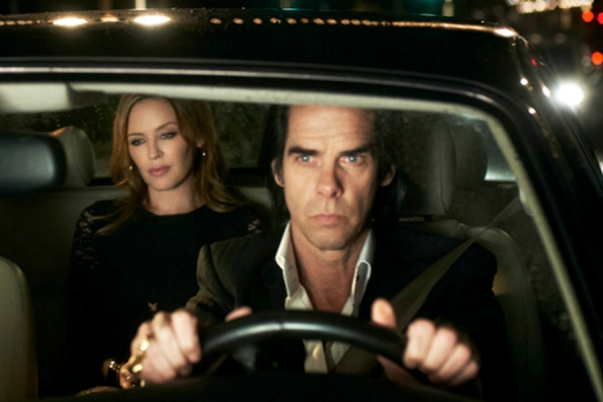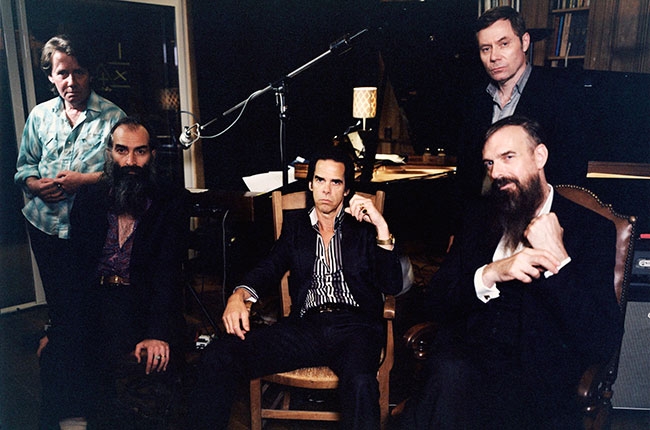20,000 Days On Earth | reviews, news & interviews
20,000 Days On Earth
20,000 Days On Earth
Nick Cave's art is exposed in a playful, funny doc
This excellent documentary considerably deepens the Nick Cave we know. If there is a Cave other than the spiritually and intellectually ravenous rock star with the raven hair, bone-dry wit and shamanic showman seen here, a bumbling secret identity behind the crafted persona, co-directors Iain Forsyth and Jane Pollard don’t want to know.
 Visual artists Forsyth and Pollard’s first feature film instead draws Cave’s creative instincts out into the light, by providing him with stimulating situations. Most arrestingly, he drives Kylie Minogue (pictured right, with Cave), Ray Winstone and ex-Bad Seed Blixa Bargeld along Brighton’s coast road, as each quizzes him from the back seat. Filming the singer’s free responses within such staged scenarios, surprising revelations result.
Visual artists Forsyth and Pollard’s first feature film instead draws Cave’s creative instincts out into the light, by providing him with stimulating situations. Most arrestingly, he drives Kylie Minogue (pictured right, with Cave), Ray Winstone and ex-Bad Seed Blixa Bargeld along Brighton’s coast road, as each quizzes him from the back seat. Filming the singer’s free responses within such staged scenarios, surprising revelations result.
Very funny ones, too. Rummaging through the Nick Cave Archive, Cave turns lecturer (“Next slide, please”) to explain the sequence of photos showing just how the late Birthday Party bassist Tracy Pew punched a German fan who was pissing on him on-stage. Lunch with current right-hand Bad Seed Warren Ellis (an off-putting bowl of eels Cave picks at unhappily, in a house where Ellis does not, in fact, live) lets the singer relax even more. He’s the audience for once as Ellis (pictured, below right), with the Outback John the Baptist beard currently in Bad Seeds fashion, holds forth. The humorous intellectual enquiry which fuels the apparent darkness of the music pours out, as they trade anecdotes about a star of Cave’s London Meltdown festival, Nina Simone, whose growled demand for “cham-pagne, co-caine and sausages” was meekly met. Cave’s narration of what happened when she played, terrifying then transforming the audience, is the serious outcome of such excess. The power of performance to alter the performer and those watching is essential to Cave. A climactic scene of him rampaging through “Jubilee Street” at the Sydney Opera House, rhythmically intercut with other shows, puts you on the stage, in some of the most thrilling Bad Seeds footage you’ll see.
 The staged nature of unprepared exchanges here makes you wonder quite what you’re seeing. The questions of psychoanalyst Darian Leader seem supercilious in a way Cave wouldn’t permit from a journalist; but he seems genuinely on the point of tears when the importance of his father’s death is probed. He is similarly disarmed by Kylie’s presence in the back of his car, and defenceless as Blixa Bargeld explains for the first time the musical boredom which made him leave the Bad Seeds.
The staged nature of unprepared exchanges here makes you wonder quite what you’re seeing. The questions of psychoanalyst Darian Leader seem supercilious in a way Cave wouldn’t permit from a journalist; but he seems genuinely on the point of tears when the importance of his father’s death is probed. He is similarly disarmed by Kylie’s presence in the back of his car, and defenceless as Blixa Bargeld explains for the first time the musical boredom which made him leave the Bad Seeds.
One model for this film is Godard’s One Plus One (1968), which amongst other things showed the tediously haphazard recording of the Stones’ Beggars Banquet. The sessions for the Bad Seeds’ Push the Sky Away show contrasting sharpness, as music sometimes happens full-blown. This is also a great Brighton film, giving a neon noir sheen to Cave’s adopted hometown. Finally, its fun and feints help him explain the important part of himself: the work. As the camera pulls away from Cave into the dark of the English Channel, his ideas about the art he’s devoted to become unexpectedly moving.
more Film
 If Only I Could Hibernate review - kids in grinding poverty in Ulaanbaatar
Mongolian director Zoljargal Purevdash's compelling debut
If Only I Could Hibernate review - kids in grinding poverty in Ulaanbaatar
Mongolian director Zoljargal Purevdash's compelling debut
 The Book of Clarence review - larky jaunt through biblical epic territory
LaKeith Stanfield is impressively watchable as the Messiah's near-neighbour
The Book of Clarence review - larky jaunt through biblical epic territory
LaKeith Stanfield is impressively watchable as the Messiah's near-neighbour
 Blu-ray/DVD: Priscilla
The disc extras smartly contextualise Sofia Coppola's eighth feature
Blu-ray/DVD: Priscilla
The disc extras smartly contextualise Sofia Coppola's eighth feature
 Back to Black review - rock biopic with a loving but soft touch
Marisa Abela evokes the genius of Amy Winehouse, with a few warts minimised
Back to Black review - rock biopic with a loving but soft touch
Marisa Abela evokes the genius of Amy Winehouse, with a few warts minimised
 Civil War review - God help America
A horrifying State of the Union address from Alex Garland
Civil War review - God help America
A horrifying State of the Union address from Alex Garland
 The Teachers' Lounge - teacher-pupil relationships under the microscope
Thoughtful, painful meditation on status, crime, and power
The Teachers' Lounge - teacher-pupil relationships under the microscope
Thoughtful, painful meditation on status, crime, and power
 Blu-ray: Happy End (Šťastný konec)
Technically brilliant black comedy hasn't aged well
Blu-ray: Happy End (Šťastný konec)
Technically brilliant black comedy hasn't aged well
 Evil Does Not Exist review - Ryusuke Hamaguchi's nuanced follow-up to 'Drive My Car'
A parable about the perils of eco-tourism with a violent twist
Evil Does Not Exist review - Ryusuke Hamaguchi's nuanced follow-up to 'Drive My Car'
A parable about the perils of eco-tourism with a violent twist
 Io Capitano review - gripping odyssey from Senegal to Italy
Matteo Garrone's Oscar-nominated drama of two teenage boys pursuing their dream
Io Capitano review - gripping odyssey from Senegal to Italy
Matteo Garrone's Oscar-nominated drama of two teenage boys pursuing their dream
 The Trouble with Jessica review - the London housing market wreaks havoc on a group of friends
Matt Winn directs a glossy cast in a black comedy that verges on farce
The Trouble with Jessica review - the London housing market wreaks havoc on a group of friends
Matt Winn directs a glossy cast in a black comedy that verges on farce
 Silver Haze review - daughters of Albion dealing with damage
Vicky Knight and Esmé Creed-Miles shine in a drama inspired by Knight's tragic past
Silver Haze review - daughters of Albion dealing with damage
Vicky Knight and Esmé Creed-Miles shine in a drama inspired by Knight's tragic past
 Mothers' Instinct review - 'Mad Women'
Sixties suburban duel veers between daftness and spooky power
Mothers' Instinct review - 'Mad Women'
Sixties suburban duel veers between daftness and spooky power

Add comment